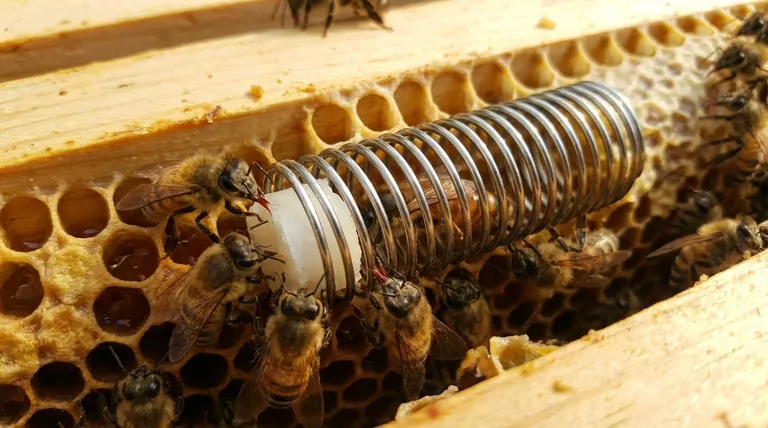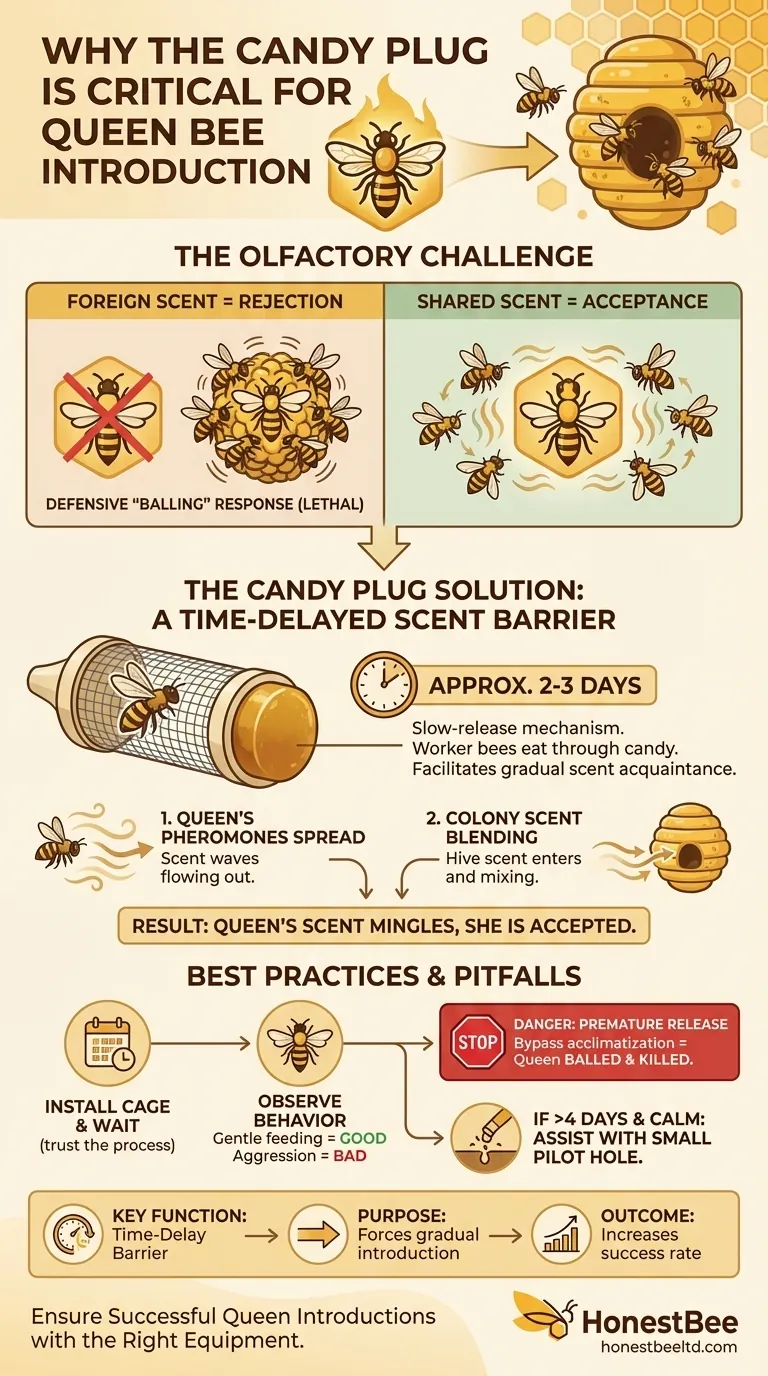The candy plug in a queen bee shipping cage is a slow-release mechanism designed to ensure the hive accepts her. It acts as a time-delayed barrier that the worker bees must eat through, giving the new queen approximately two days to acclimate. This period is essential for her scent to blend with the colony's, preventing the bees from identifying her as a foreign intruder and killing her.
The core problem is not physical introduction, but olfactory acceptance. The candy's function is to buy time, forcing a gradual scent-acquaintance period between the new queen and the hive, which is the single most critical factor in preventing her rejection.

The Science of Scent: Why Bees Reject New Queens
A beehive operates as a superorganism, and its primary mode of identification and communication is through chemical signals called pheromones. A new queen's survival depends entirely on navigating this invisible world of scent.
The Colony's "Scent Signature"
Every colony has a unique pheromonal profile, a "scent signature" composed of the queen's pheromones and the blended scents of all its members. This signature acts like a passport; bees use it to distinguish between nestmates and outsiders.
The Threat of a Foreign Scent
When a new queen is introduced, her scent is completely foreign to the hive. The colony's guard bees perceive this unfamiliar odor not as a potential new monarch, but as a dangerous invader or a rival queen.
The Defensive "Balling" Response
This perception triggers a lethal defensive behavior. Worker bees will surround the new queen in a tight ball, vibrating their wing muscles to generate intense heat. This action, known as "balling," will quickly cook and suffocate the queen.
How the Candy Plug Solves This Problem
The queen cage and its candy plug are a simple but brilliant solution to this biological challenge. It facilitates a controlled introduction that respects the colony's need for olfactory acclimatization.
A Controlled Introduction
The cage protects the queen from immediate aggression while allowing her scent to begin circulating. The wire mesh lets worker bees get close to her, touch her with their antennae, and gradually process her new pheromones.
The Two-Day Acclimatization Period
The candy plug is essentially a timer. It takes the worker bees about two to three days to chew through this sugar barrier. During this critical window, two things happen simultaneously.
First, the queen's pheromones slowly spread throughout the hive. Second, the queen begins to pick up the specific scent of the colony she is now housed in.
The Blending of Odors
By the time the worker bees chew through the candy and release the queen, her scent has mingled with the colony's scent. She no longer smells like a complete outsider, and the bees are now conditioned to her presence. She is accepted as the new mother of the colony.
Understanding the Pitfalls and Best Practices
While the candy plug is highly effective, a successful introduction requires the beekeeper to trust the process and observe the colony's behavior.
The Danger of Premature Release
The most common mistake is impatience. A beekeeper might be tempted to manually release the queen to "speed things up." This almost always ends in failure, as it bypasses the necessary scent-acclimatization period and results in the queen being balled and killed.
Checking for Acceptance
Before the queen is released, you can observe the worker bees' behavior on the outside of the cage. If they appear aggressive—biting and attempting to sting the cage—the colony is not yet ready. If they are gently feeding her through the mesh, it is a strong sign of acceptance.
When to Intervene
If after three to four days the queen has not been released, the candy may be too hard for the bees to chew through. In this specific case, a beekeeper can carefully create a very small hole in the candy with a nail to give the bees a head start on freeing her.
Making the Right Choice for a Successful Introduction
Your actions during queen introduction should be guided by careful observation of the bees' behavior, not a rigid timeline.
- If your primary focus is maximizing acceptance: Trust the process. Install the cage and allow the worker bees to release the queen on their own schedule by eating through the candy.
- If you observe continued aggression toward the cage after 24 hours: Do not release the queen. Your hive may have a hidden virgin queen or laying workers, which must be addressed before the new queen can be accepted.
- If the queen is not released after four days and the bees are calm: You can assist by creating a small pilot hole in the candy plug, but do not release her manually.
Patience is the beekeeper's most valuable tool when introducing a new queen.
Summary Table:
| Key Function | Purpose | Outcome |
|---|---|---|
| Time-Delay Barrier | Worker bees eat through candy over 2-3 days. | Forces a gradual introduction period. |
| Scent Acclimatization | Queen's pheromones blend with the colony's scent. | Prevents the queen from being identified as an intruder. |
| Prevents 'Balling' | Protects the queen from immediate lethal aggression. | Dramatically increases the success rate of queen introduction. |
Ensure Successful Queen Introductions with the Right Equipment
A failed queen introduction can set your apiary back weeks. The correct shipping cages and supplies are fundamental to protecting your investment and maintaining hive health.
HONESTBEE supplies commercial apiaries and beekeeping equipment distributors with the high-quality, reliable tools needed for successful beekeeping operations. From queen cages to essential hive management equipment, our wholesale-focused operations ensure you get the dependable supplies your business depends on.
Let's discuss your apiary's needs. Contact our team today to learn how our products can support your success and operational efficiency.
Visual Guide

Related Products
- Durable Galvanized Steel Spring Queen Bee Cage
- Multi-Function Queen Roller Cage and Catcher
- Professional Multi-Functional Queen Bee Cage
- Professional Multi-Compartment Queen Cage with Sliding Lid
- Professional Round Push-In Queen Cage with Metal Tines
People Also Ask
- Where can beekeepers purchase queen cages? Choose the Right Tool for a Successful Introduction
- Why is it important to remove burr comb around the queen cage? Ensure Hive Health and Manageability
- What should you do if the queen is still in the cage and the worker bees have not accepted her? Protect Your Colony from Queen Rejection
- How long does it typically take bees to adjust to a new queen? Master the 2-7 Day Acceptance Window
- What is the importance of correctly removing the queen cage in beekeeping? Ensure Colony Success



















